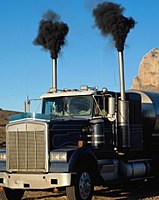
Photo from wikipedia
OBJECTIVES Diesel engine exhaust (DEE) is a known lung carcinogen and a common occupational exposure in Canada. The use of diesel-powered equipment in the construction industry is particularly widespread, but… Click to show full abstract
OBJECTIVES Diesel engine exhaust (DEE) is a known lung carcinogen and a common occupational exposure in Canada. The use of diesel-powered equipment in the construction industry is particularly widespread, but little is known about DEE exposures in this work setting. The objective of this study was to determine exposure levels and identify and characterize key determinants of DEE exposure at construction sites in Ontario. METHODS Elemental carbon (EC, a surrogate of DEE exposure) measurements were collected at seven civil infrastructure construction worksites and one trades training facility in Ontario using NIOSH method 5040. Full-shift personal air samples were collected using a constant-flow pump and SKC aluminium cyclone with quartz fibre filters in a 37-mm cassette. Exposures were compared with published health-based limits, including the Dutch Expert Committee on Occupational Safety (DECOS) limit (1.03 µg m-3 respirable EC) and the Finnish Institute of Occupational Health (FIOH) recommendation (5 µg m-3 respirable EC). Mixed-effects linear regression was used to identify determinants of EC exposure. RESULTS In total, 149 EC samples were collected, ranging from <0.25 to 52.58 µg m-3 with a geometric mean (GM) of 3.71 µg m-3 [geometric standard deviation (GSD) = 3.32]. Overall, 41.6% of samples exceeded the FIOH limit, mostly within underground worksites (93.5%), and 90.6% exceeded the DECOS limit. Underground workers (GM = 13.20 µg m-3, GSD = 1.83) had exposures approximately four times higher than below grade workers (GM = 3.56 µg m-3, GSD = 1.94) and nine times higher than above ground workers (GM = 1.49 µg m-3, GSD = 1.75). Training facility exposures were similar to above ground workers (GM = 1.86 µg m-3, GSD = 4.12); however, exposures were highly variable. Work setting and enclosed cabins were identified as the key determinants of exposure in the final model (adjusted R2 = 0.72, P < 0.001). The highest DEE exposures were observed in underground workplaces and when using unenclosed cabins. CONCLUSIONS This study provides data on current DEE exposure in Canadian construction workers. Most exposures were above recommended health-based limits, albeit in other jurisdictions, signifying a need to further reduce DEE levels in construction. These results can inform a hazard reduction strategy including targeted intervention/control measures to reduce DEE exposure and the burden of occupational lung cancer.
Journal Title: Annals of work exposures and health
Year Published: 2021
Link to full text (if available)
Share on Social Media: Sign Up to like & get
recommendations!